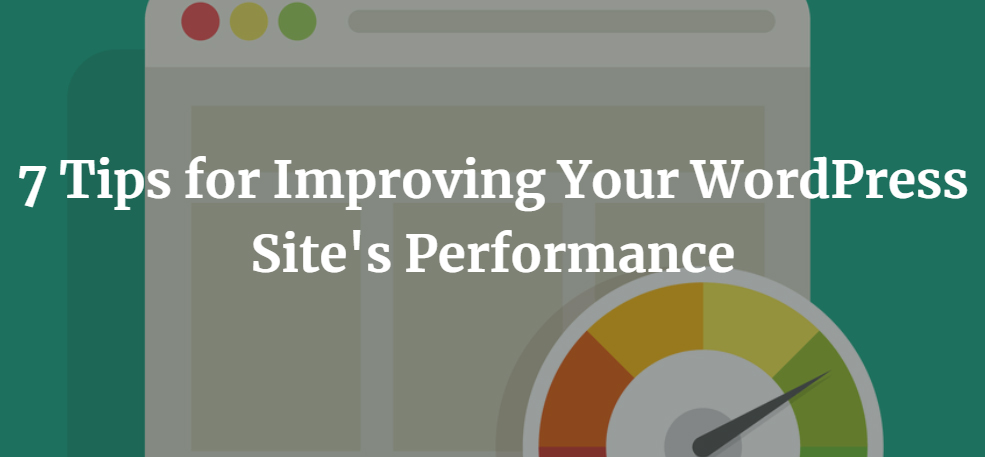7 Tips for Improving Your WordPress Site’s Performance
WordPress has made a name for itself as one of the simplest and most reliable platforms for building a blog. It’s easy enough for basic website builders to get started and complex enough to carry websites that receive hundreds of thousands of hits a day.

Just because WordPress has the potential to run like a dream doesn’t mean it will, however. Depending on the setup, the quality of the template you’re using, your hosting service, and more, your WordPress site may be experiencing a few standard performance issues.
A poorly performing website can create many problems for your business. It will increase site bounce rates and give consumers a bad impression about your brand.
But that doesn’t mean you have to deal with a poor website forever. You just need to tackle the problems with a few tried and true solutions. Most of the tips listed below you can do on your own. In case you need help, you can always hire a WordPress specialist to help you.
Improve Social Integration
The best way to get free Instagram followers, Facebook likes, and Tweets is to use social integration on your website. But are your social buttons working properly? If you’re using a bad plugin, the integration of your social sites can slow down your website or yield a faulty connection.
This looks bad for both your website and your social media pages. Choose a highly-rated plugin for your social media integration. Test them often to make sure the buttons are working correctly.
Test the Site Speed
In many cases, your high bounce rates and abandonment issues may be the result of a slow-loading website. Fast-loading webpages are very important to consumers. A collection of research published by Unbounce.com indicates that nearly half of consumers complain most about slow-loading websites when browsing the internet.
If you find that your website loads slower five seconds, you could be missing out on longer sessions and conversions. Sites that load faster than five seconds have 70 percent longer sessions than those that fully load in 19 or more seconds. Furthermore, each 100-milisecond delay in load times results in a conversion rate drop of 7 percent.
Get Better Hosting
You might apply multiple tactics on this list to try to improve your WordPress performance, but none will be fully effective if you don’t fix your hosting problem. Consider upgrading your hosting package or switching hosts altogether.
If you’re using shared hosting, and you’re struggling with site performance, it’s probably an indicator that you need to get your own host. This is a more expensive option, but the returns will be well worth it.
Specifically, you’ll want a host that’s performance oriented. The best place to look is with hosts that specifically work with WordPress. The server is optimized for WordPress, so all the other changes you’ve made to your website will be most effective.
It’s also a good idea to use an integrated content delivery system (CDN). This will store copies of your website on different servers around the world. Not only will this protect you in the event of a hosting crash, but it will also make your website faster when individuals around the globe try to access it. Again, choose a WordPress optimized CDN for best results.
Delete Old Plugins and Themes
It’s not uncommon for website owners to try a plugin or theme, be dissatisfied with the performance, and switch to something different. Many owners have a bad habit of leaving those plugged in rather than uninstalling them like they should.
Go to your WordPress dashboard and remove any old plugins and themes you’re not using. Take inventory of your currently active plugins as well. Deactivate and delete anything you don’t need.
You can do this manually or use a third-party plugin like Media Cleaner. This will scan your site for anything you’re no longer using and then ask if you’d like to delete it. That way, you can keep your site running well with minimal effort.
Use a WordPress Caching Plugin
A caching plugin is another powerful tool to automate your site performance. With high-traffic websites, a caching plugin makes it easier for files and databases to load when needed.
Essentially, a caching plugin localizes site information so that it doesn’t have to be retrieved from CSS files and databases. The stored versions of these HTML files load much faster as a result!
WordPress offers many optimized caching plugin options, but W3 Total Cache and WP Super Cache are among the most popular. If installed correctly, you can drastically decrease your site load times.
Minify on the Backend
Lean up your backend with minification. This involves reducing file sizes for JavaScript, CSS, and HTML. It also removes unnecessary characters in your coding like line breaks, spaces, and comments. As a result, there’s less data to transfer and your site can operate so much faster.
Again, you’ll want to use a WordPress-optimized plugin to automatically achieve this. WP Rocket, CSS Compressor, and Autoptimize are top-rated and offer various methods of minifying your backend so that files and web pages will load in a snap.
Optimize and Compress Images
You may be recognizing a theme here in compression. Any time you reduce file sizes, it will improve your site’s load time. Images are often the biggest culprits in slowing down your website because high-quality photos come in huge file sizes.
The best thing you can do is minimize the metadata that automatically uploads with your photo. The text is often long, undecipherable, and totally unnecessary, taking up space that you need. Optimize your photos with SEO-friendly keywords that will help your website search rankings while reducing file size. The result is a better website all around!
